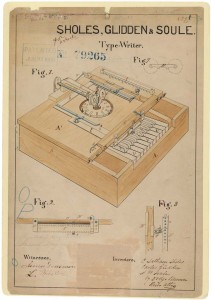Good morning, Whitewater.
Thursday in town will bring an even chance of occasional showers or thunderstorms with a high of seventy-three. Sunrise is 5:17 AM and sunset 8:37 PM, for 15h 19m 59s of daytime. The moon is a waning gibbous with 90.7% of its visible disk illuminated.
There is a Downtown Whitewater Board meeting scheduled for this morning at 8 AM.
On this day in 1868, Wisconsin resident Christopher Latham Sholes and two partners receive a patent for a “Type-Writer”:
The Sholes and Glidden typewriter had its origin in a printing machine designed in 1866 by Christopher Latham Sholes to assist in printing page numbers in books, and serial numbers on tickets and other items.[2] Sholes, a Wisconsin printer, formed a partnership with Samuel W. Soule, also a printer, and together they began development work in Charles F. Kleinsteuber’s machine shop, a converted mill in northern Milwaukee. Carlos S. Glidden, an inventor who frequented the machine shop, became interested in the device and suggested that it might be adapted to print alphabetical characters as well.[3] In July 1867, Glidden read an article in Scientific American describing “the Pterotype”, a writing machine invented by John Pratt and recently featured in an issue of London Engineering. Glidden showed the article to Sholes, who thought the machine “complicated and liable to get out of order”,[4] and was convinced that a better machine could be designed. To that point, several dozen patents for printing devices had been issued in the United States and abroad.[5] None of the machines, however, had been successful or effective products.[5][6]
In November 1866, following their successful collaboration on the numbering machine,[4] Sholes asked Soule to join him and Glidden in developing the new device. Mathias Schwalbach, a German clockmaker, was hired to assist with construction. To test the proposed machine’s feasibility, a key was taken from a telegraph machine and modified to print the letter “W”;[3] by September 1867, a model with a full alphabet, numbers, and rudimentary punctuation had been completed, and it was used to compose letters to acquaintances in the hope of selling the invention, or procuring funds for its manufacture.[7] One recipient, James Densmore, immediately bought a 25% interest for $600, the cost of the machine’s development to that date.[8][9] Densmore saw the machine for the first time in March 1868, and was unimpressed; he thought it clumsy and impractical, and declared it “good for nothing except to show that its underlying principles were sound”.[10] Among other deficiencies, the device held paper in a horizontal frame, which limited the thickness of the paper that could be used and made alignment difficult.[11] A patent for the “Type-Writer” was granted on June 23, 1868, and, despite the device’s flaws, Densmore rented a building in Chicago in which to begin its manufacture. Fifteen units were produced before a lack of funds forced the venture back to Milwaukee.[12]
A Google a Day asks a science question: “As a testament to its adaptability in urban areas, what kind of animal strolled into a popular sandwich shop in the Chicago Loop area in the spring of 2007?”

